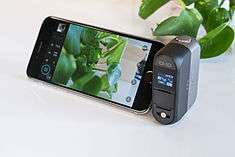DxO ONE
 DxO ONE in use with iPhone 6 | |
| Overview | |
|---|---|
| Maker | DxO Labs |
| Type | Point-and-shoot camera |
| Lens | |
| Lens | 11.9 mm (32 mm 35 mm equivalent) |
| F-numbers | f/1.8 to f/11 |
| Sensor/Medium | |
| Image sensor type | BSI-CMOS |
| Image sensor size | 13.2 x 8.8 mm (1-inch format) |
| Maximum resolution | 5406 x 3604 (20.2 megapixels) |
| ASA/ISO range | ISO 100 to 51200 (Hi 2) |
| Recording medium | microSD |
| Storage | microSD |
| Focusing | |
| Focus | Contrast detect, using face-detection |
| Focus modes | Auto, Face detect |
| Exposure/Metering | |
| Metering modes | Auto, Program, Aperture, Shutter, Manual |
| Flash | |
| Flash | Uses mobile device flash |
| Shutter | |
| Shutter speeds | 1/8000 s to 15 s |
| Viewfinder | |
| Viewfinder | uses attached mobile device viewfinder |
| General | |
| Video/movie recording | 1080p (30fps), 720p (120fps) |
| Battery | internal, non-user replacable |
| Data Port(s) | microUSB for data, Lightning for camera connection |
| Dimensions | 2.7 x 1.9 x 1.0 inches |
| Weight | 3.81 oz (108 g) |
| List price | USD 599 list price |
The DxO ONE from DxO is a small camera that attaches to a tablet or smartphone. It was originally compatible with iPhone and iPad using the Lightning connector port, and more recently with some Android phones.[1] It was introduced in June 2015.[2] The DxO ONE has a 1-inch format, 20.2 megapixel image sensor[3]—the same one that is found in the Sony Cyber-shot DSC-RX100[4]—and an f/1.8 maximum-aperture lens and high-speed shutter.[5] The ONE uses the attached mobile device as an electronic viewfinder for the camera, which does not have its own viewfinder.[6][7]
European Imaging and Sound Association awarded the DxO ONE its prize for photo innovation for 2015-2016.[8] DxO has also created a website where photographers can showcase images taken with the DxO ONE.[9]
Specifications
- 20.2 megapixel 1-inch format BSI-CMOS image sensor[10]
- Records still images in JPEG, RAW (DNG), and SuperRAW (DXO) formats
- Metering modes: Auto, Program, Shutter-priority, Aperture-priority, and Manual
- Scene modes: Sports, Landscape, Portrait, and Nighttime
- Exposure compensation adjustment
- ISO settings range from 100 - 12,800 plus 25,600 and 51,200 (Hi 1 and Hi 2) and Auto
- Focus via contrast-detect Autofocus, with face-detection, or via the touchscreen on the connected mobile device
- Video recording with single-channel audio in 1080p 30fps, or 720p 120fps for slow-motion[11]
- microSD card slot for recording images and videos
- microUSB connector for charging and transferring images and videos to a computer
The DxO ONE includes a SuperRAW image format that records four raw images in quick succession for later post-processing. Temporal noise reduction is then performed on the set of images.[12][13][14]
It can be rotated up to 60 degrees each way once it is connected via the Lightning connector. For capturing a Selfie, it can be reversed to face towards the user.[15]
Requirements
The DxO ONE works with iPads and iPhones running iOS 8 or later and that have a Lightning connector, and with some Android phones that have an USB-C connector. For proper connection between the mobile device and the DxO ONE, a case that does not occlude the area around the Lightning Connector is necessary. The DxO ONE can be used by itself, with its rear OLED screen allowing the user to switch between photo and video, but not to preview the image.[12][16]
For desktop processing of raw and SuperRAW images, an Apple Mac or Windows computer is required. Images are transferred using a separate application, DxO Connect,[17] via microUSB cable (or by directly using the microSD card that was used in the camera).[12] Apple added support for processing DxO ONE raw files in Digital Camera Raw 6.17[18] and Adobe added support for them in Camera Raw 9.2.[19]
References
- ↑ "DxO's detachable One camera is available now for Android for $499 through an early access program". 2017-11-30.
- ↑ "Analysis: DxO ONE - the World's 'First Truly Connected Camera'". Retrieved 2015-09-18.
- ↑ Fisher, Jim (18 June 2015). "DxO Tackles Hardware With One Camera". PC Magazine. Retrieved 2015-09-18.
- ↑ "DxO One". PCMag UK. Retrieved 2015-11-04.
- ↑ Fowler, Geoffrey A. "DxO One Review: Finally, an iPhone Camera Good Enough for a Pro". Wall Street Journal. ISSN 0099-9660. Retrieved 2015-11-02.
- ↑ Fisher, Jim (1 September 2015). "Hands On With the DxO One Camera". PC Magazine. Retrieved 2015-09-17.
- ↑ "DxO One review: This iPhone-connected camera isn't The One to get just yet". CNET. Retrieved 2015-11-02.
- ↑ Association, EISA - The European Imaging and Sound. "EISA - The European Imaging and Sound Association". EISA. Retrieved 2015-09-18.
- ↑ "New Shape of Photography". New Shape of Photography. Retrieved 2015-11-14.
- ↑ "First look: DxO One promises to turn iPhone into DSLR quality camera". USA TODAY. Retrieved 2015-11-02.
- ↑ "DxO ONE Review: Now Shooting!". Imaging Resource. Retrieved 2015-11-07.
- 1 2 3 "DxO One Hands On Review - Luminous Landscape". Retrieved 2015-09-18.
- ↑ UTC, Lance Ulanoff2015-09-08 21:38:22. "DxO One is pocket-sized, yet pricey photo power". Mashable. Retrieved 2015-11-02.
- ↑ "DxO One Review: Souping Up Your iPhone's Camera Comes at a Cost". Reviews. Retrieved 2015-11-02.
- ↑ "DxO One First Impressions Review". Reviewed.com Smartphones. Retrieved 2015-11-07.
- ↑ "DxO One review". The Verge. Retrieved 2015-11-02.
- ↑ "DxO releases Connect software to 'streamline' DxO One image processing". Amateur Photographer. Retrieved 2015-11-02.
- ↑ "Digital Camera RAW Compatibility Update 6.17". support.apple.com. Retrieved 2015-11-14.
- ↑ "Camera Raw 9.2 is now available". blogs.adobe.com. Retrieved 2015-11-14.